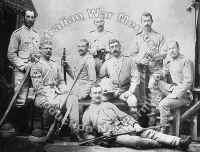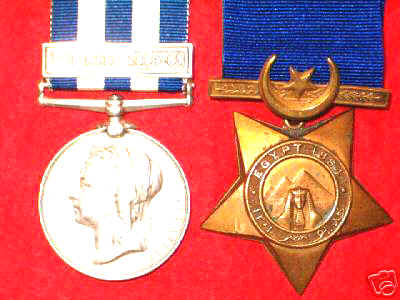|
THOSE
SUDAN DAYS
By Tom Gunning, New South
Wales Sudan Contingent
 |
SYDNEY, NSW, 1885. Infantrymen
of the NSW contingent to the Sudan, after their return to Australia.
They are wearing khaki uniform issued for active service, and are
equipped with Martini-Henry rifles. Identified are: 426 Private J.A.
Moutray (far left back row); sitting centre row, 436 Pte Louis Allen
"Curley" Parkinson, next unidentified, Private John Edwards,
Private R. Webb; 449 Sergeant J. Spence (reclining at front). J.
Spence was Superintendent of Police and L A. Parkinson was Inspector
of Police. (donor: Iris Parkinson) |
I was a member of the
New South Wales Contingent that went to the Sudan in 1885.

It is all history
now-recorded mostly in yellowing newspaper files and coldly impersonal
narratives. But as an "old soldier" who was privileged to be
among those 750 men, I carry in my mind some unforgettable memories which,
in the light of the ever-changing methods of warfare, become all the more
vivid.

War as we knew it in
1885 was a thrilling affair. There was free discussion and speculation on
all phases of the project, and the day of embarkation brought all this
excitement to a noisy climax in Sydney as we marched through the streets
to Circular Quay.
We were eager to be off
to this mysterious Sudan where 50,000 Arabs were embarrassing Britain at
an awkward time. Ours was no under-cover-of-night departure; no slogans
advising people to seal lips and save ships. Quite the reverse. We had
passed through medical examinations; we had been bellowed at on the parade
ground; we carried our old rifles, complete with saw-edged bayonets and
all this was rounded off by the glorious feeling of wearing the splendid
scarlet and blue uniform. In short, we were soldiers, and Sydney shouted
it from the housetops. London papers published pictures of our
feted departure.
 |
- The 2 official medals awarded
to the Soudan Contingent. As well the Mayor of Sydney had a
medal struck to honour the troops.
|
On the water at last-
and
Army life aboard troopship is one experience which doesn't appear to have
changed greatly since.
One of our first
shipboard jobs was to dye brilliant white equipment and pith helmets with
the only medium available: tobacco juice.
This was probably the
introduction of science of camouflage into Australia's military life and a
foreshadowing of the days when jungle green was to become fashionable for
soldiers!
Another interesting
point about our personal equipment was the charcoal water filter carried
by each man. This item consisted of a canister of charcoal granules with a
tube attached with which the water was sucked up through the filter unit.
In addition, a pair of special goggles was issued to combat glare and
dust. When not in actual use, they were usually slipped up on to the
helmet, giving one the appearance of a modern speedway rider.
Our canteens were well
stocked with tobacco and a small range of other necessities, but whatever
was lacking in the matter of things to buy, was more than compensated by
the fact that everything was free! These goods had been gifts to the
contingent by firms and individuals, and there was plenty of everything.
Iberia, carrying
the infantry, arrived in Suakin harbour on 29 March. Established at
this important Red Sea port was the Guards Brigade commanded by General Graham and
we were longing to meet and mingle with these famous soldiers. During
disembarkation, however, our feelings were somewhat ruffled to hear such
remarks as: "Blimey, Bill; these 'Walers' are white blokes!"
The "Walers"
were soon put to work though, after donning khaki jacket and trousers and
shin-length gaiters of canvas. The tunic was fitted with a long pad of
cloth running down the back to cover the spine as protection from
sunstroke. Another flap of material hung from the back of the helmet to
shelter the neck (a puggaree).
It was a rough and tough
country and, as expected, terribly hot. At halts it was useless trying to
sit on the ground, which meant that during daylight everything from
"smokos" to eating was usually carried out at "the
stand".
The rebel leader in this
area was Osman Digna, who had fled to Tamai, some twenty-one miles away.
The New South Wales Contingent was detailed to accompany an expedition to
occupy the position. This operation was duly carried out and the
Australians had their first taste of the enemy, who, incidentally, were
known as "Fuzzy-Wuzzies". It took another war to change the
Sudan soldier's conception of that term.
These dark gentry were
exceedingly nasty customers and, surprising as it may seem, they were
equipped with better arms than the British. Each man had a range of
weapons which chilled the blood of many a Guardsman. In the first place
they each carried an American Remington rifle- a far more effective weapon
than ours. This was supplemented by two spears, a "throwing stick
shaped something like a boomerang and a terrible ham-stringing
"knife-dagger" in the form of a capital J, the size of a large
carving knife and razor-sharp on every edge. To this formidable kit of
tools was added a shield altogether a strange and deadly outfit, combining
the old and the new.
A favourite
"sabotage" measure adopted by the Fuzzy-Wuzzies was to poison
the waterholes, thus defeating our filters and causing casualties. This
action necessitated the wholesale condensing of seawater on ships in
Suakin harbour and its transport to the troops in skin bags (jerbas) per
camel express. Not many Sudan men will ever forget the taste of that
water; some even maintained that poisoned water was more palatable.
The Arabs were also the
original "terrors-by-night". During the time we worked on the
Suakin-Berber railway, guard duties at night became rather an ordeal. The
natives lurked in the enveloping darkness, ready, and more than willing,
to pounce on an unwary sentry with a specially selected spear. In this
midnight stalking they used great stealth and patience. One procedure was
first to steal some grease from the railway construction job, smear their
bodies all over, then roll in the sand like a milkman's horse. Thus
camouflaged, they used to lie flat on their faces and commence a
tortuously slow slither-crawl towards our camp.
Usually the stalker would
cut a small bush, push it forward to arm's length, then inch by inch,
slither up to it. The operation would then be repeated. It was necessary
for a sentry to note the exact position of every bush in his area. Any
that moved -or appeared to move-were fired at without challenge. Morning
inspections sometimes revealed the wisdom of this action.
Not all the natives were
hostile, of course; and one tribe, the Arnaras, gave great service as
night scouts. It was when we were camped at Otao, twenty-three miles
inland, that one of their patrols discovered a Fuzzy-Wuzzy who had come to
the wells for water, bringing with him an old donkey and two jerbas. Without
ceremony the gentle Arnaras hacked off his left hand at the wrist and
continued on their way without another thought of the incident.
Next
morning one of the British Mounted Infantry, hearing groaning, cautiously
approached through the thick mimosa scrub and found the victim, who was
taken to hospital. The donkey, however, was somehow acquired by the
officers' cook who used it to carry his valise whilst in the Sudan. This
soldier actually brought the animal back to Australia, where it lived in
luxury at the Zoo, eventually expiring quietly in a paddock at Narellan,
N.S.W.
The contingent's other
mascot was a sheep -not an Arab goat-about which a section of the Press
said a great deal. Late one afternoon some thousands of sheep and goats
captured in a ravine between Handoub and Hasheen were driven through our
camp by mounted infantry. Next day we marched through the same ravine to
engage our old friend Osman Digna who had a strong force at Hasheen. Two
other columns, one from Suakin and one from Takdul, should have hemmed the
Arabs in, but were too late; and we had the mortification of seeing the
tail end of Osman's retreat.
Passing through the ravine on the outward
trip, however, we heard a faint bleating high up on the mountainside. We
mocked it and the animal responded by coming down, where it was easily
caught-a half-grown lamb, black and white, with short curly wool. It was
taken back to camp with us and commandeered by one of the men. Instead of
a battle, we got a sheep; but it really was a sheep-not a goat!
Our departure from
Suakin was a hurried affair, but the authorities were in no hurry back at
Sydney. From Friday, 27 June, until the following Tuesday we languished in
quarantine, seething with impatience. During those trying days one bright
spot was the gift of forty baskets of fish from some local fishermen. That
welcome gift is commemorated today in maps of Sydney harbour by the name
"Forty Baskets Beach".
from pages 99 and 100 of "AS YOU
WERE" 1947 by the AWM |